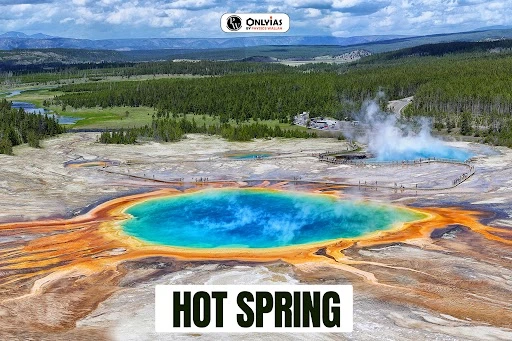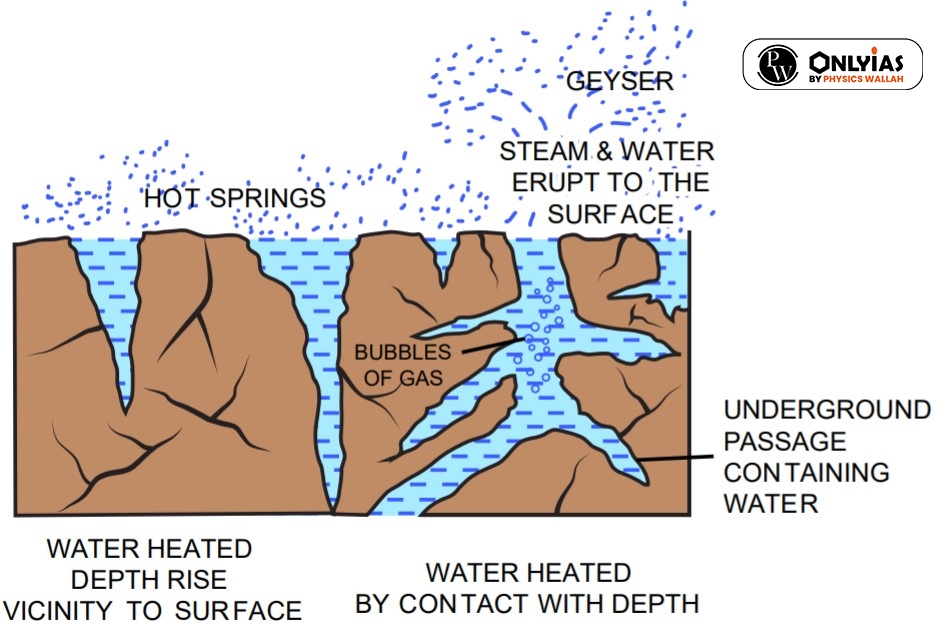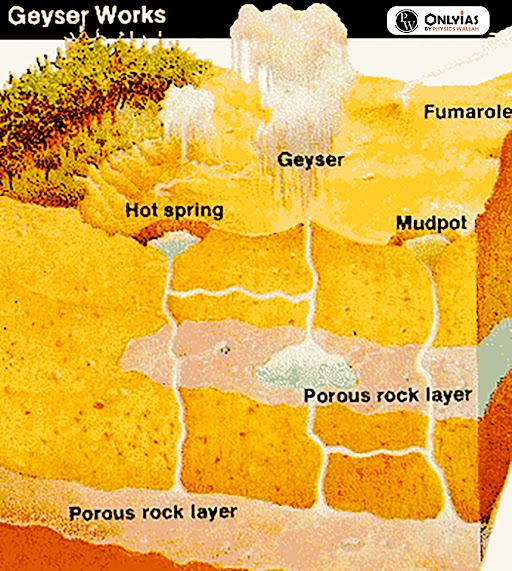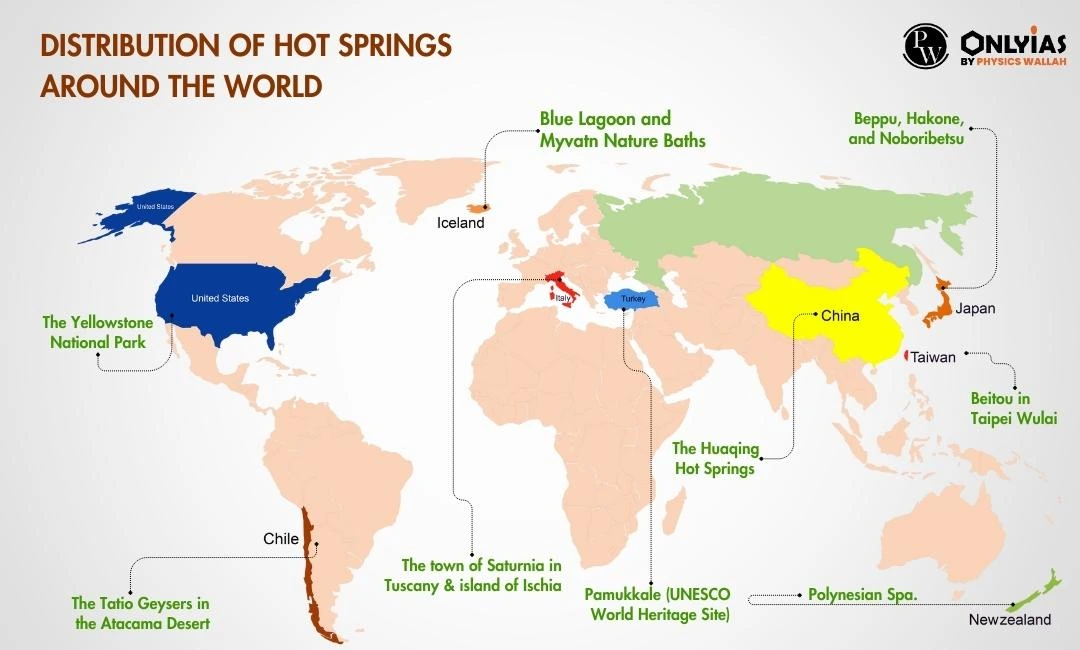Exploring the Wonders of Natural Geysers and Hot Springs
Beneath the Earth’s surface, there’s a fascinating world of hot water and spouting fountains. We call them hot springs and geysers. These natural wonders have amazed people for a long time. They’re like magic spots where really hot water comes up from the ground, and you can even relax in warm, mineral-rich pools. In this article, we’re going to learn about hot springs and geysers. We’ll explore how they work, why they’re important, and how they can make us feel better.
Hot Springs: Definition and Features
These natural wonders are a testament to the Earth’s fiery core, where molten rock and subterranean waters collide to create pockets of soothing warmth.
From the steaming geysers of Yellowstone National Park to the serene onsens of Japan, hot springs have a worldwide presence.
- Definition: A hot spring is a natural water source that emerges from the Earth’s surface, typically heated by geothermal activity beneath the ground.
- Features:These springs are characterised by the elevated temperature of the water, which is often significantly warmer than the surrounding air or groundwater.
- Some hot springs are extremely hot and can reach temperatures of over 200 degrees Fahrenheit, while others are cooler and more comfortable for bathing.
- They are also known as: Geothermal springs, Hydrothermal springs, Thermal springs.

Rising Warmth: The Intriguing Formation of Hot Springs
There are two main ways that hot springs can form:
- When rainwater or groundwater comes in contact with magma (molten rock) near the surface of the Earth.
- When water is heated by the radioactive decay of elements in the rock deep in the Earth’s crust.
- In both cases, the hot water rises to the surface through cracks or faults in the Earth’s surface.
The Significance of Hot Springs in Health, Geology, and Culture
- Health Benefits: These are known for their mineral content, which is believed to offer various health benefits, including pain relief, improved blood circulation, healing of skin problems, and potential immune system enhancement.
- Geothermal Indicators: They serve as indicators of geothermal activity and volcanic potential in a region.
- They provide valuable insights into the temperature, pressure, and composition of subsurface rocks and fluids, which can be essential for geothermal energy exploration and understanding the Earth’s geological processes.
- Cultural and Historical Significance: Hot springs have cultural and historical importance in various societies around the world.
- They are often associated with sacredness, spirituality, mythology, and art.
- Throughout history, they have been places for social interaction, recreation, and tourism, contributing to the cultural heritage of different regions.
Distribution of Hot Spring in India and Around the World
| Distribution | Description |
| Hot Springs in India |
|
Natural Geysers: Nature’s Amazing Heat Show
Geysers are nature’s hydrothermal wonders, captivating and mystifying observers with their explosive displays of hot water and steam. These remarkable geological features can be found scattered across the globe, but they are particularly prominent in regions with high levels of geothermal activity, such as Yellowstone National Park in the United States and the Haukadalur Valley in Iceland.
- Definition :A geyser is a type of hot spring that erupts periodically, sending a column of hot water and steam into the air.
- They are caused by the heating of groundwater by magma near the surface of the earth.
- They are rare natural phenomena that require specific geological conditions to form.
- Some of the most famous geysers in the world are located in Iceland, New Zealand, Chile, Russia, and the United States.
Exploring the Marvels of Natural Geysers: Formation, Types, and Spectacular Eruptions
- Water Seepage: Water seeps down through cracks and fissures in the surface rocks, gradually making its way into the Earth’s crust.
- This water can infiltrate to depths of more than 2,000 metres (approximately 2 kilometres).
- Heating by Volcanic Activity: As the water descends into the Earth’s crust, it encounters rocks that have been heated by volcanic activity.
- The geothermal heat causes the water to reach its boiling point, but the boiling temperature increases with depth due to the higher pressure underground.

- Boiling and Expansion: The heated water begins to boil, but because of the high pressure at these depths, it does not immediately flash into steam.
- Instead, it expands and pushes some of the water up the conduit, which is a narrow channel or pipe within the geyser.
- Pressure Drop and Feedback Loop: As the water is forced up the conduit, it creates a pressure drop in the reservoir below.
- This pressure drop causes more water to boil and flash into steam, which further expands and drives more water up the conduit.
- This creates a feedback loop, with increasing pressure and more boiling water as the process continues.
- Geyser Eruption: The feedback loop of boiling water and expanding steam continues until the pressure becomes too great.
- Eventually, this pressure is released in a powerful eruption, sending a column of water and steam high into the air.
- This is the iconic eruption of a geyser.
|
Types of Geysers |
|
| Cone Geysers |
|
| Fountain Geysers |
|
| Cyclic Geysers |
|
| Continuous Geysers |
|
| Sputtering Geysers |
|
| Mud Geysers |
|
| Cold Water Geysers |
|
| Superheated Water Geysers |
|
| Steam Geysers |
|
| Steam Geysers |
|
Some of the Most Famous Geysers in The World
- Old Faithful Geyser: A cone geyser in Yellowstone National Park, USA, that erupts about every 90 minutes with an average height of 40 metres.
- Geysir: A fountain geyser in Haukadalur, Iceland, that gave its name to all geysers. It used to erupt regularly up to 70 metres high, but has become less active in recent years.
- Strokkur: Another fountain geyser in Haukadalur, Iceland, that erupts every 5 to 10 minutes with a height of 15 to 20 metres.
- Steamboat Geyser: The tallest active geyser in the world, located in Yellowstone National Park, USA. It can reach heights of over 100 metres, but its eruptions are unpredictable and rare.
- Velikan (Giant) Geyser: The largest geyser in the Valley of Geysers, Kamchatka, Russia. It can erupt up to 40 metres high for about 10 minutes, but only once or twice a year.
Some of the Famous Natural Geysers in India
- Chumathang and Panamik in Ladakh: These are two of the most popular geysers, located in the Nubra Valley of Ladakh.
- The water is rich in sulphur and minerals, and is believed to have medicinal properties.
- Tattapani in Himachal Pradesh: This is located near Shimla. It is situated on the banks of the Sutlej river, and has a temperature of about 65°C.
- The water is also said to have healing powers, and many people visit it for curing skin diseases, joint pains, and fatigue.
- Manikaran in Himachal Pradesh: This is a sacred geyser in India, located near Kullu. It is associated with Hindu and Sikh legends, and is revered by both communities.
- Garampani in Assam: This is a unique geyser in India, located near Karbi Anglong district. It has been active for over 50 million years.
- The water is clear and odourless, unlike most other geysers.

- Unkeshwar in Maharashtra: This is located near Nanded. It is situated on the banks of the Penganga river, and has a temperature of about 45°C.
- The water contains traces of radium, which gives it a reddish hue.

Difference between Hot Spring and Geyser
| Characteristic | Hot Spring | Geyser |
| Water Source | Heated groundwater rises to the surface | Heated groundwater erupts periodically |
| Water Temperature | Warm to hot water | Extremely hot water |
| Consistency | Steady flow of water | Intermittent eruptions |
| Eruption Pattern | No eruptions | Periodic eruptions |
| Geothermal Features | Often surrounded by mineral deposits | May have a cone or vent structure |
| Location | Typically found in hot spring areas | May be found in geothermal fields |






























